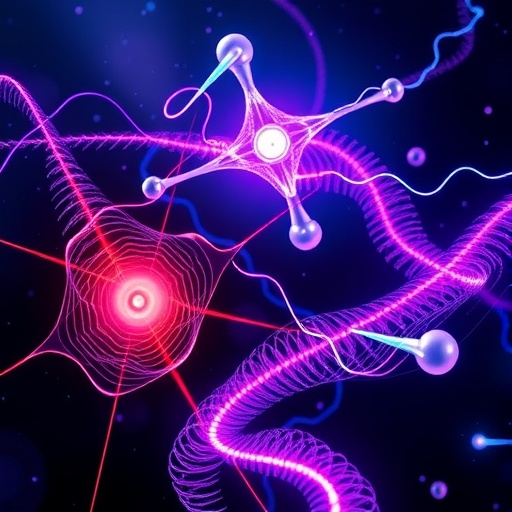Unraveling the Metabolic Shift in Methanogens: Nickel Limitation Sparks a Rerouting of Electron Flow
In a groundbreaking study published in Nature, researchers have unveiled a fascinating adaptive mechanism in CO₂-reducing hydrogenotrophic methanogenic archaea that allows these microorganisms to thrive under conditions of nickel scarcity. This discovery not only redefines the biochemical landscape of methanogenesis under metal-limiting environments but also showcases one of the most extreme examples of metal-dependent metabolic switching observed in nature.
Methanogens are a group of archaea responsible for methane production, predominantly through the reduction of CO₂ with H₂ as the electron donor. Traditionally, this process relies heavily on nickel-dependent enzymes, especially [NiFe]-hydrogenases such as Frh and Mvh. These enzymes facilitate the transfer of electrons necessary for the reduction steps in methanogenesis. However, under conditions of nickel limitation, the availability of these critical metalloenzymes becomes substantially reduced, raising the question: How do methanogens sustain their metabolism when nickel is scarce?
The recent study, led by Nomura and colleagues, has demonstrated that methanogens possess a versatile electron-donating apparatus capable of switching between nickel-dependent and nickel-independent pathways. This switch involves a gene cluster encoding the ElpAB complex, which, intriguingly, is widespread among CO₂-reducing hydrogenotrophic methanogens. ElpAB works in concert with the Hdr complex, effectively substituting for the traditional [NiFe]-hydrogenases when nickel becomes limiting.
Comparative genomic analyses revealed that the presence of ElpAB parallels that of Hmd, a nickel-dependent [Fe]-hydrogenase, within methanogen genomes. Notably, in genomes where Hmd is absent, but the [NiFe]-hydrogenases are present, alternative enzymes like FdhA and FdhB appear to form analogous complexes to maintain electron flow. This functional redundancy hints at an evolutionary adaptation that allows these archaea to mitigate the dependency on nickel, thereby expanding their ecological niches.
To validate the functionality of the nickel-independent pathway, the team conducted proteomic analyses on Methanothermococcus thermolithotrophicus, a methanogen phylogenetically distant from Methanothermobacter marburgensis, a species previously characterized for the nickel-dependent pathway. Under nickel-sufficient conditions, ElpAB complex proteins were detected and their expression increased marginally when nickel was restricted. Strikingly, the levels of the [NiFe]-hydrogenases FrhAGB and MvhAG decreased drastically under nickel limitation, suggesting a deliberate rerouting of electron flow.
Despite the genome of M. thermolithotrophicus lacking ElpC—a homologue of MvhD that generally serves as an electron connector—MvhD was constitutively expressed and likely participates in both Elp–Hdr and Mvh–Hdr complexes. This illustrates a remarkable flexibility in the electron transport chain architecture, further supporting the existence of a nickel-independent pathway that maintains metabolic function when the availability of key metals is constrained.
The practical implication of these findings is immense. Methanogens clearly possess the inherent capability to toggle between electron transfer pathways based on metal bioavailability, an insight that challenges the canonical understanding of methanogenic biochemistry. Such metabolic plasticity likely provides a selective advantage in natural environments where metal ions fluctuate due to geochemical processes, expanding the ecological breadth of these archaea.
Further emphasizing this switch, the quantities of membrane-bound [NiFe]-hydrogenases, specifically Eha and Ehb, were detected at less than 1% of the levels of Hmd under nickel limitation, underscoring the minor role nickel-containing enzymes play during metal scarcity. Instead, the coupling of Hmd and Mtd with the Elp complex and Hdr drives the electron transfer, ensuring continuous methane production even under challenging environmental conditions.
Figure 4 of the original study provided a schematic comparison of the methanogenic pathway under nickel-rich and nickel-limiting conditions. In the former, Frh and Mvh dominate the electron donation process via their [NiFe] active sites. Conversely, under nickel limitation, these enzymes are significantly downregulated, and the system pivots towards a synergistic operation involving the non-nickel [Fe]-hydrogenase Hmd alongside Mtd, with Elp complexed to Hdr fulfilling the electron transfer role.
This groundbreaking revelation reflects what can be described as an “extreme example of metal-dependent switching” — where the entire core metabolism of methanogens dynamically shifts the electron flow from nickel-reliant enzymes to alternative, nickel-independent systems. Such adaptability marks a fundamental physiological strategy allowing methanogens to endure and maintain methane production regardless of trace metal availability.
The conservation of both Hmd and Elp genes across a wide range of class I methanogens indicates that these microorganisms frequently encounter nickel-limited milieus in nature. Moreover, the widespread retention of [NiFe]-hydrogenases like Frh and Mvh implies that methanogens remain versatile across environments where nickel is either abundant or scarce, swiftly redirecting electron flow to match metal bioavailability.
Looking ahead, the research invites transcriptomic and metagenomic studies of environmental samples where bioavailable nickel levels can be quantified. Such investigations will clarify the environmental significance of nickel-independent methanogenesis and how it contributes to global methane cycles, particularly in geochemically variable habitats.
By unveiling the intricate control methanogens exercise over their electron transport pathways via metal availability, this study also opens avenues for biotechnological applications. For instance, engineering methanogens or synthetic consortia that optimize methane production under metal-limiting conditions could enhance bioenergy production and bioremediation strategies.
In summary, the study by Nomura et al. redefines the boundaries of metabolic flexibility in methanogens by elucidating an alternative nickel-independent electron flow pathway operational under metal scarcity. This discovery not only enriches our understanding of archaeal physiology but also illustrates the remarkable evolutionary adaptations that sustain life in fluctuating and often harsh environmental conditions.
Subject of Research: Electron flow pathways in hydrogenotrophic methanogenic archaea under nickel limitation.
Article Title: Electron flow in hydrogenotrophic methanogens under nickel limitation.
Article References:
Nomura, S., San Segundo-Acosta, P., Protasov, E. et al. Electron flow in hydrogenotrophic methanogens under nickel limitation. Nature (2025). https://doi.org/10.1038/s41586-025-09229-y
Image Credits: AI Generated




